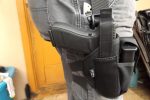I still remember when the Glock 20 and 21 first came out, and I owned both, That was when I worked for the late Col. Rex Applegate. The Glock 20 is a 10mm pistol, and the Model 21 is chambered in .45 ACP. Other than the chamberings, both guns are alike in many ways. However, the 10mm version didn’t balance as nicely in my hand as the .45 ACP version did. Of course, the 10mm barrel is a little bit thicker, while the .45 ACP version has a barrel that is thinner because of the larger diameter bullet. You’d assume that both guns would feel the same – but they don’t. And, I ran a test with a number of shooters, and they all said the same thing, the Model 21 felt better and balanced better in their hand. So, it wasn’t just me.
For quite a few years, the 10mm round was “the” caliber to have, it would stop a charging rhino with a single shot, or shoot down a jet fighter from 10-miles up. Well, that wasn’t true and it still isn’t! The 10mm was a hard-hitting, and hard recoiling round in any handgun, but with practice, it is controllable. The FBI even went to the Smith & Wesson 1076 chambered in 10mm. The only problem was, like many in law enforcement, they aren’t really into guns, per se. The FBI and most polices departments just weren’t willing to invest the training time and money to properly transition their agents and officers. So, in short order, the FBI abandoned the 10mm and went to the .40 S&W – which is a shorter, and more watered-down round than the 10mm was – but it is still a 10mm diamerter bullet. And many ammo makers started reducing the power of the 10mm, until it was down to near the same power as the .40 S&W.
Today, the 10mm is making a comeback and many ammo makers are once again loading the 10mm caliber to what it used to be. Two ammo makers, Buffalo Bore Ammunition and Double Tap, are making some really hot 10mm rounds these days, and I’ve shot both brands in various 10mm handguns. Of course, we are in the worst ammo drought in history, and all calibers are extremely difficult to find on dealer’s shelves. The 10mm is very difficult to find these days. (It takes either a lot of luck or tools like ammoseek.com, to find any.) Our local small box stores have had no 9mm ammo or .45 ACP on their shelves for several months now, and if you are lucky enough to find some ammo, you are limited to only two boxes per caliber, per day.
The Glock 21 that I have is a Gen 4 version that comes with variety of thickness backstraps. It was made in good ol’ Georgia, USA. Prior to this, the first Generation examples were made in Austria, where Glock is headquartered. Here in the United States, Glock has established a service center as well as actually producing many of their models in Georgia.
A little bit of specification info on the Glock 21 is in order, of course: This is a full-sized service handgun. However, with the right clothing and holster, you can still conceal it fairly well. The Model 21 has a 4.61-inch barrel, making it shorter than a full-sized 1911 Government Model. The gun weighs in at 26.28 ounces, with no magazine in place, and 29.28 ounces with an empty magazine, and roughly 39-ounces with a loaded magazine, depending on bullet weight. The slide is 1.12-inches wide at the widest point, so it is right in there, with a 1911 handgun, and at the widest point, the gun is 1.34-inches wide.
 The trigger reach is not a stretch at all for me. I have large hands, but not overly large, and I can easily reach the trigger. Of course, being chambered in .45 ACP, the frame is thicker/wider because the .45 ACP round is longer than a 9mm or .40 S&W – still it’s not a problem for me at all. The magazines hold 13-rounds, and that’s a lot of ammo on-board. The gun comes with three of those 13-round mags, too. The slide is topped with a white, outlined rear sight – very fast to pick up, and the front sight had one white dot. My only minor complaint is that the Glock factory sights are plastic. Whenever I can afford it, I’m going to replace the sights, with all-steel tritium night sights. The rear of the slide had serrations on both sides, for a sure hold when chambering a round. The frame is black polymer, and has outstanding pointy raised dimples all the way around – again, you can get a great hold on this gun no matter the weather conditions.
The trigger reach is not a stretch at all for me. I have large hands, but not overly large, and I can easily reach the trigger. Of course, being chambered in .45 ACP, the frame is thicker/wider because the .45 ACP round is longer than a 9mm or .40 S&W – still it’s not a problem for me at all. The magazines hold 13-rounds, and that’s a lot of ammo on-board. The gun comes with three of those 13-round mags, too. The slide is topped with a white, outlined rear sight – very fast to pick up, and the front sight had one white dot. My only minor complaint is that the Glock factory sights are plastic. Whenever I can afford it, I’m going to replace the sights, with all-steel tritium night sights. The rear of the slide had serrations on both sides, for a sure hold when chambering a round. The frame is black polymer, and has outstanding pointy raised dimples all the way around – again, you can get a great hold on this gun no matter the weather conditions.
 As is typical with all Glocks, the trigger is “mushy” but you can get used to it, in short order. It breaks at 5.5-pounds – great for self-defense work. Of course, we have the little “blade” safety in the middle of the trigger, if you don’t have a proper purchase on the trigger, while pressing it to fire, the gun won’t fire, plus there are other internal passive safeties as well. The magazine catch is large, like those found on all Gen 4 Glocks, easy to hit it to drop a mag for a fast reload. The frame of the Gen 3 and later Model 21 has a Picatinny-style slot on the underside, for attaching a light and/or laser if you wish. There are finger grooves on the front of the backstrap, I can do without those, but they are there if you like that sort of thing.
As is typical with all Glocks, the trigger is “mushy” but you can get used to it, in short order. It breaks at 5.5-pounds – great for self-defense work. Of course, we have the little “blade” safety in the middle of the trigger, if you don’t have a proper purchase on the trigger, while pressing it to fire, the gun won’t fire, plus there are other internal passive safeties as well. The magazine catch is large, like those found on all Gen 4 Glocks, easy to hit it to drop a mag for a fast reload. The frame of the Gen 3 and later Model 21 has a Picatinny-style slot on the underside, for attaching a light and/or laser if you wish. There are finger grooves on the front of the backstrap, I can do without those, but they are there if you like that sort of thing.
Last I checked, the Alaska State Troopers were all carrying Glock 21 pistols – and that makes good sense, in the event, they had to dispatch a wounded big game animal, you need a bigger bullet for that. Plus, in the cold temps in much of Alaska in the winter months, in the event they might have to engage a bad guy, who is wearing a lot of heavy clothing, you want a round that hits hard, and penetrates deeply as well.
 If you own a Glock 20 or 21, then you have, no doubt, found that finding holsters for these guns can be a bit of a chore. Because these two guns are bigger overall compared to the 9mm and .40 S&W calibers, they won’t fit in holsters for these two calibers. Glock, of course, makes their little “combat” style plastic holster and mag pouches for these two bigger guns, and they are reasonably priced, too. Some other makers, like Blackhawk Products also have a couple of their holsters that will work with these bigger guns. I elected to use a tactical thigh holster from Craft Holsters for carrying this Glock 21 on some logging roads. I like this holster a lot. It has an attached mag pouch for carrying a spare 13-round magazine – nice! You really need to check out their entire line of holsters, bet you’ll find a couple for your handguns, at very nice prices, too.
If you own a Glock 20 or 21, then you have, no doubt, found that finding holsters for these guns can be a bit of a chore. Because these two guns are bigger overall compared to the 9mm and .40 S&W calibers, they won’t fit in holsters for these two calibers. Glock, of course, makes their little “combat” style plastic holster and mag pouches for these two bigger guns, and they are reasonably priced, too. Some other makers, like Blackhawk Products also have a couple of their holsters that will work with these bigger guns. I elected to use a tactical thigh holster from Craft Holsters for carrying this Glock 21 on some logging roads. I like this holster a lot. It has an attached mag pouch for carrying a spare 13-round magazine – nice! You really need to check out their entire line of holsters, bet you’ll find a couple for your handguns, at very nice prices, too.
Recoil? Really nothing to be concerned about with the Glock 21, it is a fairly easy-shooting big bore handgun, believe it or not, even with full-powered loads, as well as lighter loads. Of course, as already mentioned, we are in the worst ammo drought in history, and ammo – in all calibers – is hard to find. So, I was very limited for the ammo that I could run through this Glock 21. I managed to find some CCI Blazer 230-gr FMJ rounds, from my personal stash. It has been my experience, that Blazer handgun ammo is a little bit underpowered compared to other brands of ammo. Still, the 21 perked along just fine, never missed a beat. In all, I fired 150-rounds – more than I should have, because of limited ammo supplies, but this gun is just a lot of fun to shoot.
From Black Hills Ammunition, I had their 230-gr FMJ, 200-gr SWC match grade, 135-gr HoneyBadger, and this is an all-solid copper bullet that is fluted – and the recoil is extremely light. I also had a little bit of the Black Hills 200-gr JHP +P, and their 185-gr Barnes Tac XT +P JHP ammo – needless to say, I didn’t shoot much of this ammo at all – only used the better stuff in my accuracy testing, and that is limited to one five-round group at 25-yards. I used to shoot several groups with each type of ammo, and took the best group in my reporting.
 At 25-yards, over a rolled-up sleeping bag, placed on a big boulder, I was pleased with my groups, the best overall group was the HoneyBadger, and I was happy to see that, it was slightly under 3-inches. The other types of ammo, gave me groups around 3.5-inches if I did my part. And, I know, from past experience with this gun, it can shoot tighter groups – all day long. For everyday carrying I would probably go with the 135-gr HoneyBadger, however, for hiking or camping out in the boonies, where I might encounter a dangerous 4-legged animal, I’d go with the Black Hills 200-gr JHP +P load. If I were in Alaska, I’d probably go with some FMJ or hard cast bullets for the best and deepest penetration into those animals. One of the nice things about a .45 ACP is that you have a big range of ammo to choose from, for whatever you think you’d run into.
At 25-yards, over a rolled-up sleeping bag, placed on a big boulder, I was pleased with my groups, the best overall group was the HoneyBadger, and I was happy to see that, it was slightly under 3-inches. The other types of ammo, gave me groups around 3.5-inches if I did my part. And, I know, from past experience with this gun, it can shoot tighter groups – all day long. For everyday carrying I would probably go with the 135-gr HoneyBadger, however, for hiking or camping out in the boonies, where I might encounter a dangerous 4-legged animal, I’d go with the Black Hills 200-gr JHP +P load. If I were in Alaska, I’d probably go with some FMJ or hard cast bullets for the best and deepest penetration into those animals. One of the nice things about a .45 ACP is that you have a big range of ammo to choose from, for whatever you think you’d run into.
I wanted to pick up some genuine Glock factory-made 13 -round magazines for this pistol, but none could be found. Again, the ammo drought isn’t just about ammo shortages, it is also causing magazine shortages. There are some higher capacity mags being made in South Korea for the Glock 21, that hold 27-rounds. I’ve tested them – they are not reliable – so save your money.
Before closing out this article, I wanted to point out that our esteemed Editor, James Rawles, carries a Glock .45 on a daily basis on the Rawles Ranch – where he could easily encounter black bears and grizzly bears, that could pose a threat. He tells me that is usually that is a Glock Model 30, but he also owns and carries several Glock 21 pistols. But in either case, he always carries them with a 13-round Glock 21 magazine in the mag well.
I won’t even report how little I once paid for my Glock 21, but I checked some of the online gun-selling websites, and I’m seeing them from $799 up to a lot more than that. Sadly, I don’t expect firearm prices to drop – ever again – now that we have both general price inflation and a new anti-gun President in place.
If your hand size is big enough, to comfortably get a good grip on the Glock 21 (or 20) then check one out, if you can find it – it is a real man’s sized gun, to be sure.










